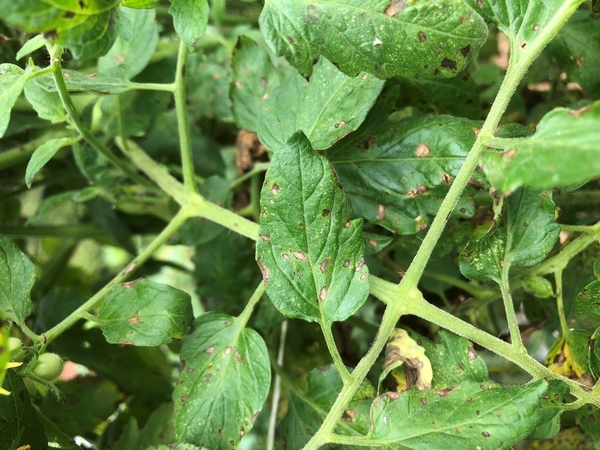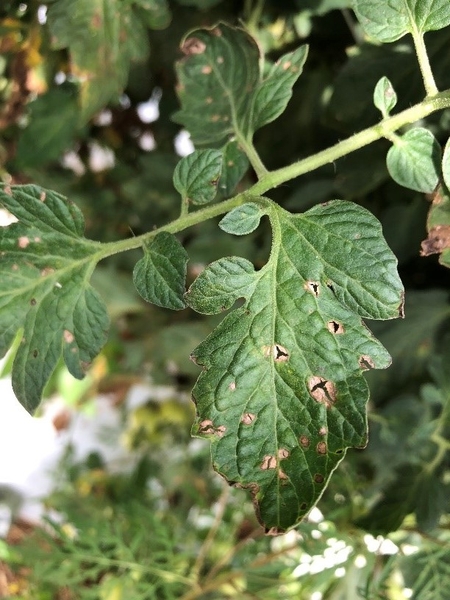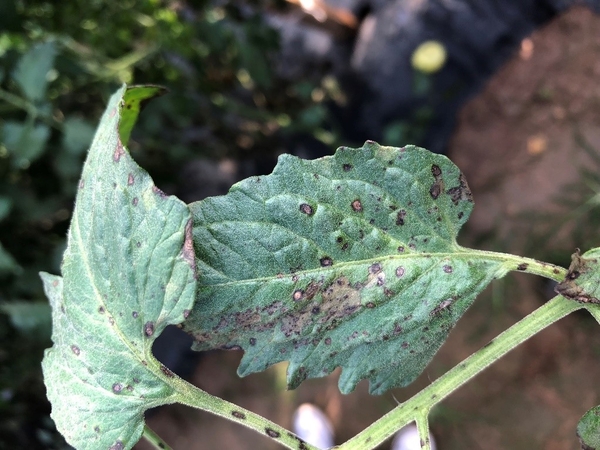Introduction
Gray leaf spot of tomato (Solanum lycopersicum) is a destructive disease in warm, humid climates around the world that results in severe plant defoliation. Many commercially available hybrid varieties of tomato contain genes for resistance to this disease, but with the increased cultivation of heirloom tomatoes in the southeastern US, the disease is increasingly prevalent in North Carolina.
Pathogen
Gray leaf spot of tomato is caused by three species of Stemphylium: S. solani, S. lycopersici (= S. floridanum), and S. botryosum.
Host Plants
According to the USDA host-fungal database, these species of Stemphylium are capable of infecting tomatoes, peppers, cucumbers, and lettuce. The organism has also been reported to infect garlic, cotton, tobacco, ground cherry, gladiola, blue lupine, horsenettle and other solanaceous weeds.
Symptoms and Signs
Symptoms first appear as numerous small, circular to oblong, gray to black specks on the upper and underside of lower leaves (Fig. 1). The spots enlarge without restriction by leaf veins and may eventually crack in the middle and coalesce, ultimately resulting in defoliation (Fig. 2). Leaf yellowing often accompanies enlargement of lesions. Under very favorable conditions for disease, lesions may develop on leaf petioles and stems, but this occurs rarely. Symptoms do not occur on fruit, but defoliation results in decreased fruit quality and yield.
Lookalike diseases. Initial symptoms of early blight of tomato can mimic those of gray leaf spot. However, early blight lesions expand rapidly and become much larger compared to those of gray leaf spot. Additionally, early blight lesions often contain concentric circles and are often observed on leaves, stems, and fruit (Fig. 3). Symptoms of Septoria leaf spot also look similar to those caused by gray leaf spot, however, lesions form on stems and petioles and have dark-brown margins with tan to gray centers (Fig. 4). Yellow halos often appear around these lesions, also.
View this brief video to help you identify gray leaf spot of tomato.
Disease Cycle and Epidemiology
The pathogen is able to survive for multiple seasons on volunteer tomato plants, alternate hosts, or crop debris in warmer climates. It is suspected to overwinter throughout North Carolina. The fungus is an excellent saprophyte that can grow readily on decaying plant material, even if the dead material is from a nonhost or resistant plant. Spores (conidia) can be spread by wind and water splash, and germinate quickly between temperatures of 24-27ºC in the presence of moisture on the leaf surface. Under favorable conditions, symptoms are often evident within 5 days of infection. The disease may begin by transplanting infected seedlings into the field, or, infection may occur after transplant of healthy seedlings.
Disease Management for Conventional and Organic Growers
Grow resistant varieties. Host resistance is the most effective way to manage this disease. If susceptible varieties are desired, grow them in the early season and switch to resistant varieties later in the season when disease pressure is highest. Many varieties of commercially available hybrid tomatoes are resistant to this disease and should be planted. Work is underway to introduce resistance genes into heirloom-type tomatoes, however, many heirloom varieties remain susceptible to this disease. Based on recent research, below is a table of varieties that have been tested and are known to be either susceptible or resistant.
| Variety | Resistant or Susceptible | Growth habit, fruit type |
|---|---|---|
| Mountain Girl | Resistant | indeterminate, round |
| Mountain Rouge | Resistant | indeterminate, round |
| Sun Leaper | Resistant | determinate, round |
| Enroza | Resistant | indeterminate, round |
| Lemon Boy Plus | Resistant | indeterminate, round |
| Damsel | Resistant | indeterminate, round |
| Mountain Merit | Resistant | determinate, round |
| Hot Streak | Resistant | indeterminate, round |
| Mountain Heritage | Susceptible | indeterminate, round |
| Striped German | Susceptible | indeterminate, round |
| Malachite Box | Susceptible | indeterminate, round |
| Pink Brandywine | Susceptible | indeterminate, round |
| German Johnson | Susceptible | indeterminate, round |
| Black Magic | Susceptible | indeterminate, round |
| Black from Tula | Susceptible | indeterminate, round |
| Kelloggs Breakfast | Susceptible | indeterminate, round |
| Cherokee Purple | Susceptible | indeterminate, round |
| GinFiz | Susceptible | indeterminate, round |
| Apple Yellow | Susceptible | indeterminate, cherry |
Crop rotation. Crop rotation may reduce the introduction and persistence of the pathogen. Infested fields should be rotated away from tomato or pepper to a non-host for a minimum of 3 years. However, it is important to combine crop rotation with other disease management strategies as this alone will not manage disease once introduced.
Eliminate weeds. Eliminate weedy hosts and volunteer tomato plants prior to planting. Additionally, limit their growth throughout the growing season.
Reduce moisture on leaf surface. Infection is favored under warm, moist conditions. Therefore, planting rows parallel to the prevailing wind direction may promote leaf drying and help reduce infection. Additionally, reducing plant density may promote leaf drying.
Biological pesticides and organic chemicals. There are no known biopesticides that effectively manage gray leaf spot. We do not have data on the efficacy of copper products to manage this disease.
Fungicide applications. Fungicides should only be used when a susceptible variety of tomato is planted. Refer to the Southeastern US Vegetable Crop Handbook for more information on products available to manage this disease. Always read the label before applying a fungicide.
| Product name | Active Ingredient | FRAC | Comments |
|---|---|---|---|
| Quadris | azoxystrobin | 11 | Do not make more than 1 application before rotating to a different fungicide with a different mode of action. |
|
Aprovia Top |
difenoconazole + benzovindiflupyr |
7 + 3 |
Do not make more than 2 applications before alternating to a non- Group 7 fungicide. See label for application intervals and limits per season. Use of a spreading adjuvant is recommended. |
|
Inspire Super |
difenoconazole + cyprodinil |
3 + 9 |
Limit of 80 fl oz/acre/season. Do not make more than 2 consecutive applications before alternating to a fungicide with a different mode of action. |
| Fontelis | penthiopyrad | 7 | 16 to 24 fl oz/acre. Limit of 72 fl oz/acre/season. Do not make more than 2 consecutive applications before rotating to a fungicide with a different mode of action. |
|
Luna Tranquility |
fluopyram + pyrimethanil |
7 + 9 |
See label for limits on application amounts per season. Do not make more than 2 applications of Group 7 or 9 fungicides without switching to a different mode of action. |
| Mettle | tetraconazole | 3 | 6 to 8 fl oz/acre. Do not make more than 2 consecutive applications before rotating to a fungicide with a different mode of action. |
|
ManKocide |
mancozeb + copper |
M3 + M1 |
Limit of 58 lb/acre/season East of the Mississippi River. |
|
- |
mancozeb |
M3 |
- |
|
- |
chlorothalonil |
M5 |
- |
Disease Management for Homeowners
Resistant varieties. Planting resistant varieties is the best strategy to manage this disease. Follow recommendations in the "Disease Management for Conventional and Organic Growers" section.
Prevent introduction. Avoid introduction of this pathogen into a garden by buying disease-free transplants.
Crop rotation. Crop rotation can be employed to minimize the likelihood of introduction and reduce inoculum once disease is present. Infested plots should be rotated to nonhosts for a minimum of 3 years.
Eliminate weeds. Because weedy hosts can serve as a host to the pathogen, weed management is critical.
Destroy affected crops. If you find symptomatic plants in your garden, remove them and destroy them by burning or by disposing of them in a landfill.
Fungicide applications. Fungicides should only be used when a susceptible variety of tomato is planted. A list of fungicides available to homeowners is available. Always read the label before applying a fungicide.
Resources
- The NC State Extension Plant Disease and Insect Clinic provides diagnostic services and control recommendations
- The NC State Extension Plant Pathology portal provides information on crop disease management
- The Southeastern US Vegetable Crop Handbook provides information on vegetable disease management
Publication date: Feb. 21, 2022
Reviewed/Revised: Sept. 7, 2022
N.C. Cooperative Extension prohibits discrimination and harassment regardless of age, color, disability, family and marital status, gender identity, national origin, political beliefs, race, religion, sex (including pregnancy), sexual orientation and veteran status.




